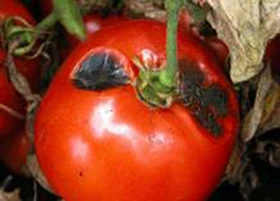
 by Mary Hausbeck, Michigan State University Extension, Department of Plant, Soil and Microbial Sciences
by Mary Hausbeck, Michigan State University Extension, Department of Plant, Soil and Microbial Sciences
Photo 1: Early blight on tomato foliage.
The most common fungal leaf blight and fruit rots of tomato in the Michigan production region are early blight (Alternaria solani), Septoria blight (Septoria lycopersici), and anthracnose (Colletotrichum coccodes).
Early blight infects foliage and ripening fruit and seems to be especially troublesome for growers who have not kept up on their preventive fungicide sprays. Infection can occur at the point of attachment to the stem and through growth cracks and wounds on the fruit. The early blight fungus causes dark brown, leathery sunken spots with concentric rings. Infection is greatest in warm weather (75 to 85 degrees Fahrenheit). Heavy dews, extremely humid weather and abundant rainfall are essential for early blight. A 3- to 4-year crop rotation can help reduce the levels of the early blight fungus in the soil.
Septoria blight is severe in our tomato research plots in East Lansing and appears to progressing rapidly on plants that were not protected with fungicide. This is a common foliar disease and may occur on the tomato plant along with other tomato-loving pathogens. Rapid defoliation of Septoria-infected plants may occur when the weather is warm with frequent rain showers. This loss of foliage results in yield loss and sunscald of the remaining fruit. In general, a tomato plant infected with Septoria will have lower leaves that have become peppered with small, dark circular spots. These spots will increase in size, with the centers of these spots becoming light tan in color with dark margins. The disease normally spreads from the lower leaves to the upper leaves on the diseased plants.
Anthracnose is considered to be the most serious ripe-fruit rot of tomatoes. Without good fungicide control, 70 percent of the fruit may become diseased. Symptoms appear only on ripe or senescent fruit (Green fruit can become infected, but the symptoms do not appear until the fruit ripens). Symptoms include slightly sunken circular lesions that may expand and coalesce. Fruit may become infected while green, but symptoms do not appear until they become ripe. Anthracnose fruit rot symptoms begin as small, dark, sunken lesions that have a water-soaked appearance. Lesions increase in diameter and coalesce, leaving a large, sunken, soft area. Under favorable temperatures, lesions on ripe fruit become visible within 5 to 6 days after the initial infection. As lesions mature, very small, dark fruiting structures form beneath the infected fruit tissue. The leaves appear to be unaffected by anthracnose.
Late blight (Phytophthora infestans) is a disease that most commonly affects potatoes, but can infect tomatoes in some years. When the weather is favorable as it has been this year, late blight can be especially troublesome. This disease was recently reported in Michigan from a commercial potato field in Allegan. The late blight spores from this infected potato field can infect nearby tomatoes. Tomato growers practicing IPM use fungicides to protect against early blight, Septoria, and anthracnose and many of these fungicides also provide adequate protection against late blight.
Late blight symptoms include blighting on all aboveground parts of the tomato plant. Lesions on leaves often appear dark and oily with production of spores occurring on the undersides of the leaves resulting in a purplish appearance especially when conditions are wet and humid. Blackened lesions on the stems also occur and are unique to late blight disease. Late blight affects green and ripened tomato fruit. The other commonly occurring tomato diseases do not cause a rot of the green fruit. The blighting on fruit from late blight appears as dark, greasy areas that enlarge rapidly encompassing the entire fruit. During wet and humid conditions, white threads (mycelium) can be seen on the fruit.
Between cropping seasons, the late blight pathogen survives on volunteer and abandoned potato and tomato plants in fields, cull piles and home gardens. Cool nights, moderately warm days and weather that keeps foliage and fruit wet for several hours are ideal for late blight development. Control measures include eliminating all potato or tomato cull piles in the vicinity of tomato plantings and destroying volunteer potato plants that grow from overwintered tubers. All tomato varieties are susceptible to late blight. In addition to the fungicides commonly used for early blight, Septoria and anthracnose, there are several highly effective fungicide sprays that are late blight specific that can be used to protect tomato plants from this disease (Please see Michigan State University Extension Bulletin E312 for a listing of fungicides that are registered).
Photo credits: Mary Hausbeck, MSU
Dr. Hausbeck’s work is funded in part by MSU‘s AgBioResearch.
Latest from Produce Grower
- Jim Jones, FDA deputy commissioner for human foods, resigns over mass staff cuts
- Orbia's precision agriculture business Netafim releases Hybrid Dripline system
- Ledgnd opens second location, adds new functionalities to MyLedgnd software portal
- This fast and agile robotic insect could someday aid in mechanical pollination
- Hydrofarm joins GLASE as premium industry member
- Food safety leaders unite for LinkedIn live event on effective communication in crisis
- UGA professor Erich Schoeller to discuss IPM best practices for CEA at Indoor Ag-Con 2025
- New York grower rebrands to Nimble Farms





